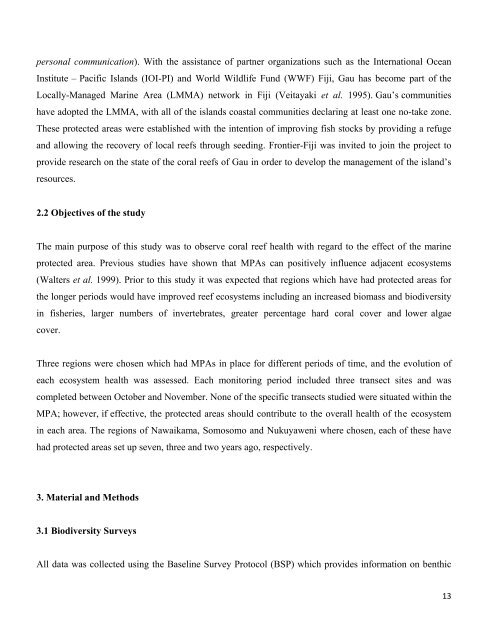Frontier Fiji Marine Environmental Research - Frontier-publications ...
Frontier Fiji Marine Environmental Research - Frontier-publications ...
Frontier Fiji Marine Environmental Research - Frontier-publications ...
Create successful ePaper yourself
Turn your PDF publications into a flip-book with our unique Google optimized e-Paper software.
personal communication). With the assistance of partner organizations such as the International Ocean<br />
Institute – Pacific Islands (IOI-PI) and World Wildlife Fund (WWF) <strong>Fiji</strong>, Gau has become part of the<br />
Locally-Managed <strong>Marine</strong> Area (LMMA) network in <strong>Fiji</strong> (Veitayaki et al. 1995). Gau’s communities<br />
have adopted the LMMA, with all of the islands coastal communities declaring at least one no-take zone.<br />
These protected areas were established with the intention of improving fish stocks by providing a refuge<br />
and allowing the recovery of local reefs through seeding. <strong>Frontier</strong>-<strong>Fiji</strong> was invited to join the project to<br />
provide research on the state of the coral reefs of Gau in order to develop the management of the island’s<br />
resources.<br />
2.2 Objectives of the study<br />
The main purpose of this study was to observe coral reef health with regard to the effect of the marine<br />
protected area. Previous studies have shown that MPAs can positively influence adjacent ecosystems<br />
(Walters et al. 1999). Prior to this study it was expected that regions which have had protected areas for<br />
the longer periods would have improved reef ecosystems including an increased biomass and biodiversity<br />
in fisheries, larger numbers of invertebrates, greater percentage hard coral cover and lower algae<br />
cover.<br />
Three regions were chosen which had MPAs in place for different periods of time, and the evolution of<br />
each ecosystem health was assessed. Each monitoring period included three transect sites and was<br />
completed between October and November. None of the specific transects studied were situated within the<br />
MPA; however, if effective, the protected areas should contribute to the overall health of the ecosystem<br />
in each area. The regions of Nawaikama, Somosomo and Nukuyaweni where chosen, each of these have<br />
had protected areas set up seven, three and two years ago, respectively.<br />
3. Material and Methods<br />
3.1 Biodiversity Surveys<br />
All data was collected using the Baseline Survey Protocol (BSP) which provides information on benthic<br />
13
















